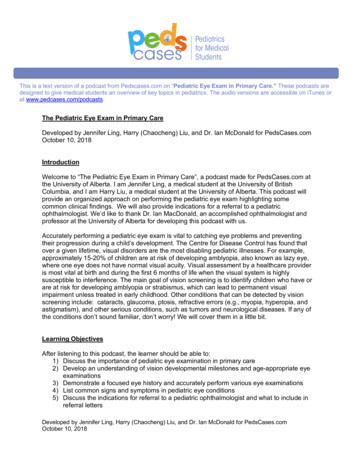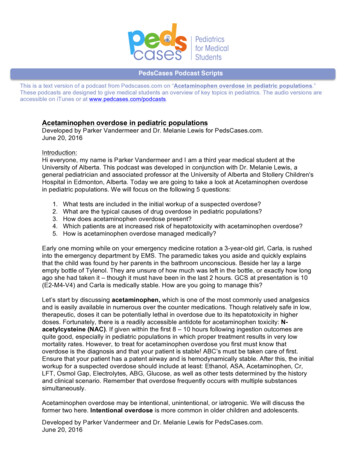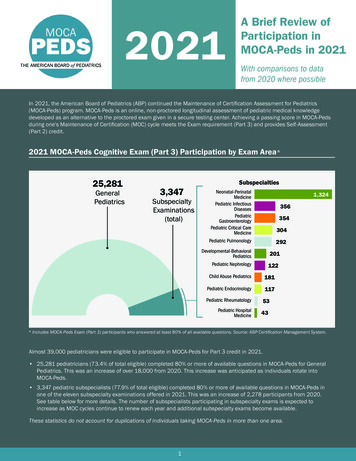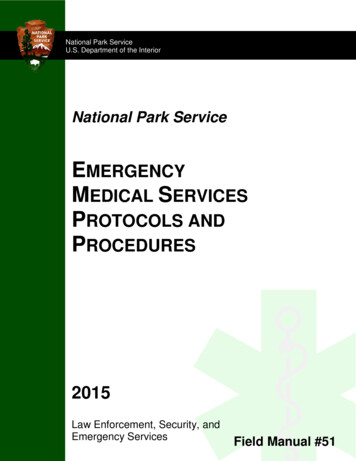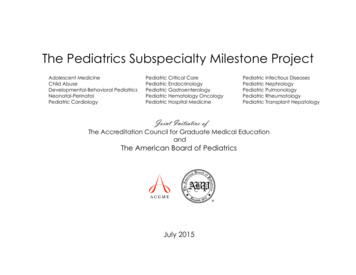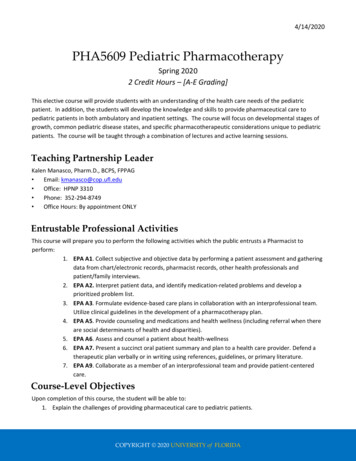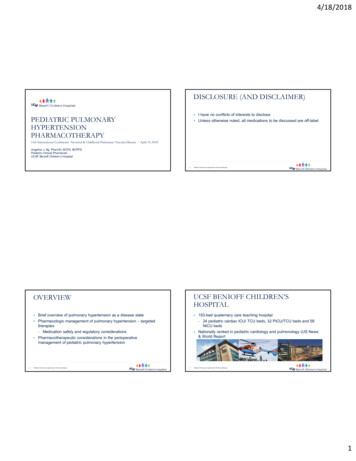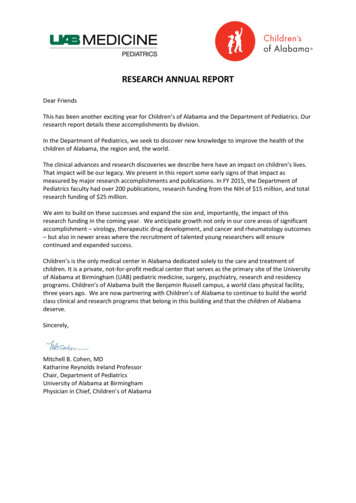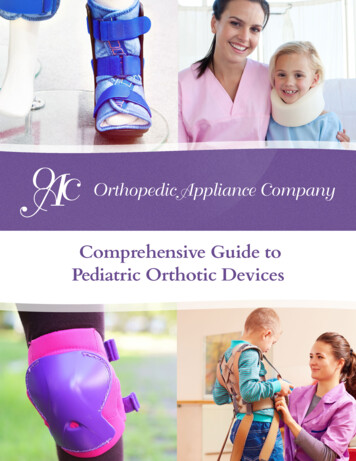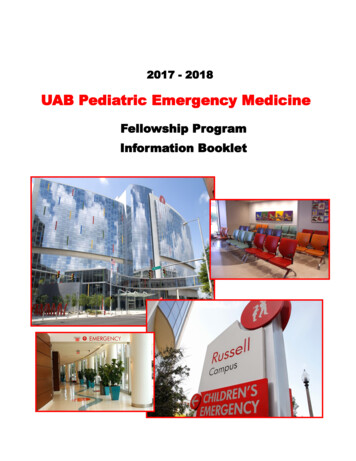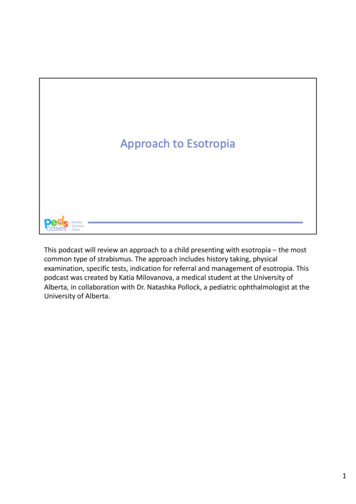
Transcription
This podcast will review an approach to a child presenting with esotropia – the mostcommon type of strabismus. The approach includes history taking, physicalexamination, specific tests, indication for referral and management of esotropia. Thispodcast was created by Katia Milovanova, a medical student at the University ofAlberta, in collaboration with Dr. Natashka Pollock, a pediatric ophthalmologist at theUniversity of Alberta.1
Today we will cover the following learning objectives on the topic of esotropia:1) Define and differentiate the main categories of esotropia.2) Develop an approach to evaluating a patient with esotropia.3) Delineate appropriate urgent and non-urgent ophthalmology referrals foresotropia.4) Discuss general treatment approaches for esotropia.2
Let’s work through a clinical case as we go, so we can apply the information we arelearning. You are a medical student working at an urban family medicine clinic. Tim isa 2.5 year old boy presenting with a new onset esotropia. His mother is worriedbecause she has been noticing his left eye turning in over the last few weeks.Before we begin, we must define ‘strabismus’. Strabismus is simply abnormalalignment of the eyes; one or both eyes may deviate from their primary position.Esotropia is a type of strabismus, in which one or both affected eyes look in towardsthe nose (colloquially termed ‘cross-eyed’). This is the most common type ofstrabismus, occurring in 2-4% of the population (which is almost 1 in 20 kids!).3
It is very important to diagnose and correct esotropia before stereopsis developsaround the age of 4. Here are three important reasons why:1) To prevent amblyopia. Poor eye alignment can cause amblyopia (termed “lazyvision”) and occurs exclusively in children. Amblyopia can result in permanent visionloss in that eye if untreated prior to visual maturity.2) To ensure proper development of stereopsis (which means depth perception).3) To negate the detrimental effects of strabismus on psychosocial development andemployment opportunities. Studies demonstrate that esotropia can decrease anindividual’s quality of life. Children with noticeable strabismus are rated morenegatively by others than those with normally aligned eyes on characteristics such asintelligence, trustworthiness, aggressiveness and others (1,2).With the importance of diagnosis and treatment in mind, let’s work on an approachto Tim’s presentation.4
Is this real strabismus?First, we have to determine if this esotropia is “real”. Esotropia may be confused withbenign conditions such as:1) Ocular instability of infancy (also known as transient misalignment of the eyes) –this is a normal misalignment that may occur in the first few months of life. This iscommon up to 3 months of age and the eyes align on their own as the baby growsand their coordination develops. There is no need to worry unless concerns persistoutside of this window.2) Pseudostrabismus – specifically pseudoesotropia in our case – is an optical illusionof esotropia due to a wide nasal bridge or large epicanthal folds (where less of theinner sclera is seen). This will resolve as the nasal bridge grows. It should be notedthat this diagnosis should be made by a pediatric ophthalmologist and is a diagnosisof exclusion. In most cases, patients are followed over time to ensure that anintermittent esotropia is not missed.- A symmetrical corneal light reflex will rule out a true esotropia. (Thiswill be explained in the physical exam section).We examine Tim and determine that it cannot be ocular instability of infancy due to5
his age, nor is it pseudostrabismus as there is an asymmetric light reflex. We suspecttrue esotropia. Let’s move on to understand this a little bit more.5
Esotropia can be categorized in a few different ways. As we continue to work Tim up,we want to distinguish between the following types:1) Constant vs. intermittent esotropia.-Constant esotropia is always present, while intermittent is only present inselect situations (for example, when the child is tired and/or sick). There canbe varying degrees of control of the intermittent esotropia.2) Comitant vs. incomitant esotropia.-Comitant esotropia is when the deviation is the same degree in all positionsof gaze, while incomitant is when the deviation is more pronounced in specificdirections of gaze.-Incomitant esotropia can be a red flag and indicate CN6 palsy.3) Congenital/infantile esotropia.-This subtype presents during the first 12 months of life. It can rarely occurimmediately from birth.-Essentially, since both eyes turn in equally, the infant uses their right eye tolook to the left side and their left eye to look to the right side. This is knownas “crossfixation”.4) Accommodative vs. non-accommodative esotropia.-Accommodative esotropia is typically first noted around 2 years of age, when6
children begin to colour, read, and do other close-up activities.-It is noticeable when the child is trying to focus on something up close andtheir eye turns inwards excessively. (However, if the child is very far sighted,this may occur even when they’re trying to focus on something further away).-In normal-sighted children, focusing on something up close causes their eyesto automatically converge on that object just the right amount.-If a child is quite hyperopic (far-sighted), they must focus extra hard onobjects up close for them to be clear, and their eyes may converge too much –causing their eyes to cross.-This can be corrected to varying degrees with glasses.A note on mechanism:There are 6 extraocular muscles that move the eye. Strabismus can be idiopathic,familial, or caused by anything impacting these muscles or the nerves that innervatethem (CN 3, 4 and 6). Sometimes this is related to brain injury (for example, due tohypoxic ischemic encephalopathy or cerebral palsy) and other times the cause issensory, due to the interruption of sensory input entering the eyes (for example, dueto a cataract).As we go through the history and physical exam, we will be trying to narrow downwhich of these is the cause for our patient’s presentation. Of note, often, no specificcause for esotropia can be discovered.6
Let’s move on to clinical presentation. For History, on top of everything you wouldnormally ask, ensure to go over these points that are specific to esotropia.1) Does the child have any co-morbid medical conditions? Certain neuromuscularconditions can also be risk factors, such as cerebral palsy, muscular dystrophy, Downsyndrome or head trauma. These can affect eye development and how the braininterprets visual information.2) Ask about the birth and developmental history - premature/low birth weight is arisk factor for esotropia.3) Is there any family history of esotropia? This is a major risk factor for developingthe condition.4) When did it start? You can recommend that parents bring in photos of their childfor the next appointment if they can’t remember, so that you can narrow this downtogether.5) When does it happen? That is, is it constant or intermittent?6) Is there presence of diplopia (double vision)? This is typically only present in olderkids in situations of acute esotropia.7) Does the child have any other ocular problems? For example, a high refractiveerror that would force the child to have to focus all the time can put them at risk foresotropia.7
Tim has been tracking along the 5th percentile for height and weight since shortlyafter birth. He was born small for gestational age at 2400 grams. His mom thinks sheremembers noticing the inturning of his left eye for the first time three weeks ago athis grandma’s 70th birthday. It comes and goes, but is especially apparent when he isplaying with his favourite block set up-close. He does not seem to see double and hasno other known problems with his eyes. He has no other medical conditions andthere is no family history of esotropia.7
Now it’s time for the Physical Exam:This template focuses on the steps in an eye exam that would be especially high yieldfor an investigation of esotropia.1) Assess their general development.-Assess their growth and any other medical conditions they may have.2) Note any abnormal head posturing.-Children may tilt, turn or rotate their heads to improve their visual acuity oravoid diplopia. Abnormal head posture can be a compensatory mechanismand an indication of incomitant strabismus. Noting this can help narrow downthe diagnosis.3) For the basic ophthalmic exam, depending on the child’s age you may not be ableto complete the full exam. Do as much as you can; if they are more comfortable, letthe child sit on their parent’s lap.-First, the anterior eye exam:-Inspect the position and alignment of their eyes for any asymmetry.-Also inspect their eyelid position for any asymmetry, width ofpalpebral fissures, lid edema, colour, lesions, trauma and for completelid closure.-Pay particular attention to any ptosis (drooping eyelids). This8
can be primary and/or gaze-induced.-Second, assess extraocular movements.-Ask the child to demonstrate the 6 cardinal positions of gaze bygetting them to follow your finger as you draw an H.-Look for inability of the eyes to move in certain directions.-Also look for compensatory overactions.-Third, assess visual acuity and colour vision.-Remember to do this at their best corrected vision - that is, the childshould be wearing their glasses if they have any.-Pick the test that matches the child’s age and maturity best. Examplesof tests are the Snellen chart, Sheridan-Gardner test or tumbling Echart.-Fourth, assess visual fields - this is one component that can be extra difficultwith younger children.-Fifth, assess the pupils. These are especially important to assess for CNIIIparesis or intraocular pathology.-Inspect for size, shape and symmetry between both eyes.-Examine reactivity to a pen light.-Assess for relative afferent pupillary defect (RAPD) with the swinginglight test.-Assess the red reflex, demonstrated in the image: stand 2-3 feet awayfrom the child and shine the largest diameter of light at their eyes, soyou can see through both pupils at once. Compare the reflex.-If the test is positive (i.e. the red reflex is asymmetrical interms of colour, size, shape or brightness), refer the patient toa pediatric -ophthalmologist immediately.-In the image, only the first set of eyes has a normal red reflex.The rest would need referral.-This asymmetry may be due to cataracts, or potentiallysomething more sinister like a retinoblastoma.-There may also be bilateral dulling of the reflex which couldindicate pathology in both eyes.-The Brückner test uses the red reflex to detect anisometropiaand strabismus.-The last part of the ophthalmic exam is examining the posterior segment,including optic nerve assessment via fundoscopy.8
4) Next are special tests specific to esotropia:-First is the corneal light reflex or Hirschberg test – this is an easy test forocular alignment. It is especially useful for large deviations. It is shown in theleft-most image.-To do it: place a toy 2-3 feet in front of the child and shine a penlightinto their eyes from the same location – the light reflex should besymmetrical in both pupils. If an eye is turned inwards, the light reflexwill be displaced laterally outwardly. The image provided demonstratesthe opposite condition: EXOtropia, as the light reflex is displacedmedially.-As mentioned earlier, this test is an efficient way to distinguishbetween pseudostrabismus and true strabismus. The corneal lightreflex will be symmetrical in pseudostrabismus because the child’seyes aren’t truly misaligned, they just appear to be misaligned due totheir facial features.-If the corneal light reflex is not symmetrical, this demonstrates thepresence of strabismus and is an indication for a referral to a pediatricophthalmologist.-Next, the cover test – this test helps detect strabismus that is always present9
(called manifest strabismus). It is shown in the middle image.-Ask the child to fixate on an object and cover one of their eyes.Observe the opposite uncovered eye to see if it moves to adjust.-The uncovered eye should not move! If the test is positive (and theuncovered eye moves) – refer the patient. No further testing required.-Ensure to repeat on the second eye.-Finally, the cover/uncover test – this test is used to look for smallerdeviations and strabismus that occurs only when the eye is shut or covered(called latent strabismus). You may also hear it being called the cross-cover oralternate cover test. It is shown in the right-most image.-Ask the child to fixate on an object and cover one of their eyes.-Quickly remove the cover and observe the previously covered eye tosee if it moves to adjust.-The previously covered eye should not move! If the test is positiveand the eye moves – refer the patient.-Ensure to repeat on the second eye.Tim’s height and weight measurements in the office continue to track along the 5thpercentiles. There are no other noticeable ophthalmic findings aside fromsignificantly decreased visual acuity. Red reflex test is negative (ie. pupils aresymmetric and bright) and the corneal light reflex test is asymmetric and confirms atrue esotropia. Tim’s cover/uncover test is positive, confirming strabismus.9
Indications for Referral:1) Refer all suspected esotropias to a pediatric ophthalmologist. Ocular instability ofinfancy and pseudostrabismus can be difficult to distinguish from true esotropia.When in doubt, refer to a specialist.When making a referral take note of your physical exam findings and any features inthe history that places the child at risk for developing true esotropia such asprematurity, genetic conditions or family history.Also refer if the child has:2) Unexplained torticollis/head position.3) Complaints of diplopia or asthenopia (which is fatigue with up-close work).The following are red flags and merit an emergency referral:1) An abnormal red reflex test.2) Esotropia presenting acutely in an older child.3) Esotropia with neurological symptoms, such as diplopia, nystagmus, headache,nausea or vomiting.4) Esotropia in conjunction with other ocular abnormalities (ie. ptosis, inability to10
move eyes fully or anisocoria)10
Now, let’s chat about Treatment:It is a myth that children will “outgrow” true esotropia – in fact, the condition can getworse without treatment. Functional improvements (such as depth perception) canonly occur with correction before 4-5 years of age.If the deviation is small ( 10 degrees) and both fusion (the combining of images fromeach eye) and stereopsis (depth perception) are evident, then regular observation byan ophthalmologist may be enough.Otherwise, regardless of the subtype of esotropia or the etiology, the goal oftreatment is three-fold: to obtain clear vision in each eye, for the eyes to align and forthe eyes to fuse their images properly. As such, treatment is typically composed ofthree steps:1) Correct any refractive error the child may have with glasses.-This can treat certain types of esotropia, like accommodative esotropia.2) Correct any amblyopia (“lazy vision”) the child may have with patching.-The difference between refractive error and amblyopia can be confusingsometimes – think of refractive error as an issue with the optics of the eye,and amblyopia as an issue with the brain choosing not to interpret what is11
being seen. It doesn’t matter how clear the image is if the brain is alreadyignoring that eye – so both need to be corrected.-Amblyopia treatment involves occluding the good eye for several hours a day,thereby forcing the brain to use the amblyopic eye that it was previouslyignoring.-Occluding the good eye with a patch is the most common form oftreatment.-If the child refuses to be patched, atropine drops are an alternative toblur the vision in the good eye.3) Finally, it may be necessary to realign the eyes with surgery or botox.-This step is only considered after the first two are tried (if applicable).-Surgery loosens or tightens the necessary extraocular muscles to cause botheyes to point in the same direction.-Botox can also be used in place of surgery to realign the eye (ie. byweakening the medial rectus), and can have a permanent effect in 50% ofcandidate patients.You may hear about eye exercises (also known as vision therapy or orthoptics) beinghelpful to reduce strabismus or strengthen vision. Other than treatment forconvergence insufficiency, there is no evidence to support it.The patient will continue to be followed by an ophthalmologist to ensure treatment isworking and that any relapses are targeted immediately. Visits will become moregradual as the child gets older and there is less chance of relapse.11
So what happened to Tim?Based on Tim’s history and physical exam results, we would refer him to a pediatricophthalmologist. The specialist diagnosed him with accommodative esotropia and hewas prescribed glasses to help with his visual acuity and to straighten his eyes. Later,the specialist prescribed patching the right eye for 2 hours a day over a period of 3months to correct his amblyopia. Since he had a fully-accommodative esotropia, nosurgery was required.12
Let’s review the Key Points from this podcast:1) Esotropia can cause amblyopia, which can develop into permanent vision loss ifnot reversed during the window of developmental plasticity (usually before the age of8).2) Esotropia can prevent the development of stereopsis (depth perception) if the eyesare not realigned by 5 years of age.3) Refer all suspected esotropia to a pediatric ophthalmologist.4) Identification of any red flags are an indication for immediate, emergency referral.Speak directly to the ophthalmologist to assist in triaging.5) Depending on the cause of esotropia, treatment is not always surgical. Glassesand/or patching may be enough to treat the deviation.13
Thank you for listening, and we hope this has made the approach to esotropia clearerfor you!14
a pediatric -ophthalmologist immediately. -In the image, only the first set of eyes has a normal red reflex. The rest would need referral. -This asymmetry may be due to cataracts, or potentially something more sinister like a retinoblastoma. -There may also be bilateral dulling of the reflex which could indicate pathology in both eyes.
